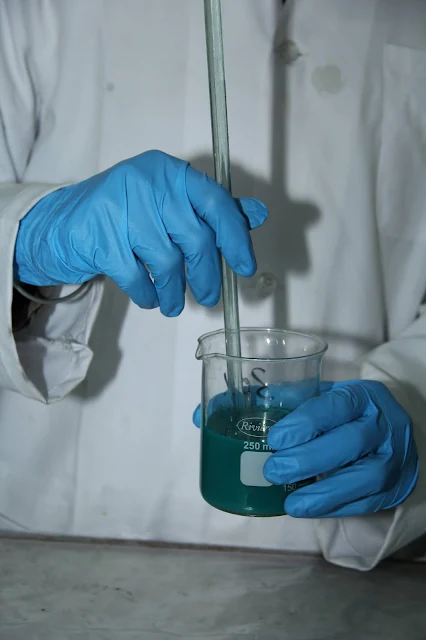This testing is the determination of Chrome in basic chrome sulfate. This method can be used to determine the Cr2O3 content in the dye, pigment powder, solution, and dispersion.
This extraction titration method can be done within our existing facilities in the chemical lab.
Procedure for determination of Chrome content
Materials and Equipment
- Chromium-containing sample
- Distilled water
- HCL
- NaOH
- KIO3 (Solution)
- hydrogen peroxide
- Indicator (KI)
- Burette
- Pipettes
- Erlenmeyer flask
- Magnetic stirrer or stirring rod
- Filter paper
Procedure
Weigh about 0.1gm of sample and basic chrome sulfate and dissolve in water.
Now add dilute sodium hydroxide solution dropwise until the precipitate initially forms and continue the addition of dilute NaOH till the precipitate redissolves.
Add 15 to 20 ml of hydrogen peroxide and boil the solution.
To ensure complete decomposition of excess peroxide, add a small piece of clean iron and continue boiling.
Filter the solution into a 250 ml iodine flask, wash the precipitate thoroughly with water, and add the washing to the filtrate.
Neutralize with HCL as indicated by the color change from yellow chromate to orange dichromate and add 5 ml excess HCL. Cool the solution, add 10 ml of 10% KI solution, and moisten the stopper with the same reagent. Allow the flask to stand for 10 minutes in the dark.
Wash the stopper and the neck of the flask with water into the solution and titrate with 0.1N Thio solution. The starch solution was used as an indicator.
The endpoint is a change of red color to green.
The solution is standardized by titrating against 0.1N KIO3.
Methyl Orange and Methyl Red Indicator Solution Preparation and Formula
Calculation of Chrome Content
1ml of 0.1N titrant = 0.00253 gm of Cr2O3.
\[\{Chrome content} = V X 0.00253*100/W\]
Where
V = volume of exact 0.1N titrant consumed.
W = weight of basic chrome sulfate/ sample taken.
BLEND OF OXIDISED & SULFITE FISH OIL TDS
Determination of Sodium Sulfate in Fatty Alkyl Sulfate
This method determines the sodium sulfate in fatty acid by precipitation of the sulfate with barium chloride. This method applies to fatty alkyl sulfate-free from an added alkaline builder.
Solution and Reagents
(I). Barium Chloride solution (100 gm/liter) Dissolve 100 gm BaCl2.2H2O in distilled water and dilute to 1 liter.
(ii). Concentrated hydrochloric acid (HCL).
(iii). Concentrated sulfuric acid (H2SO4).
Procedure
Use the entire alcohol-insoluble portion of the sample or weigh a suitable-sized portion thereof into a 1000 ml beaker. Now add 200 ml of water to the beaker and neutralize to a methyl orange indicator endpoint with HCL adding about 0.6 ml in excess.
If the solution is not clear, filter it and wash the paper until it is free of chlorides. The volume of solution from this point should be about 250 to 300 ml.
Heat to boiling. While boiling add all at once 15 to 20 ml of the Barium chloride solution. Continue boiling for a few minutes and then cover with a watch glass.
Place on the steam bath and keep the contents of the beaker hot (70 to 80 C) for 1 hour or until the precipitate has settled well. Often leaving the beaker on the steam bath overnight is an advantage.
Test the clear upper layer with a few drops of barium chloride solution to ensure that precipitation is complete. If so decant the clear layer through a 9- cm ash-less filter paper.
Then transfer the barium sulfate from the beaker to the paper using a stream of hot water from a wash bottle and with the aid of a policeman. Wash thoroughly with hot water until the washings, when tested with AgNO3, Show no chlorides.
Transfer the chloride-free residue and filter paper to a tared porcelain crucible. Ignite the paper at a low temp. so that the paper shall char without inflaming. Burn off the carbon at as low a temp. as possible with the crucible uncovered. After the carbon is burned, raise the temp. to about 800 C.
If a muffle is used burn off the paper over a burner before placing the crucible in a hot muffle. If a burner is used, care must be taken to avoid loss due to drafts. Moisten the precipitate with 2 drops of H2SO4 and reheat to remove the excess acid. Cool and weight.
Calculation
The calculation of the percentage of sodium sulfate is as follows
\[Sodium sulfate% = (A*60.86) / B\]
Where
A = grams of Barium sulfate.
B = grams of sample used.

